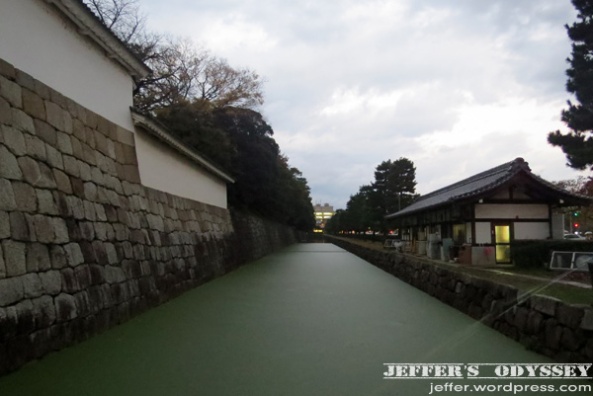I could not help but look at my now very long list of backlogs… travel posts to make, photos to upload… and I start to panic. But then when I calm down a bit, I think to myself, “all in good time, eh?” It’s already the 2nd half of May, and I think I’ll be lying low for a bit. Catch up on some ZZZZs, recharge my batteries, recoup losses, replenish travel fund… y’know, normal, ordinary things. At least, MY kind of normal & ordinary. For now, though, I’ll take you to another Kyoto jaunt: the NIJO CASTLE.
Our visit to the Kyoto Imperial Palace took more time than originally planned due, in large part, to the rain. It was almost 4pm when we got to where Nijo Castle is located, and so we barely had an hour to go around.
Nijo-jo, or Nijo Castle, is yet another UNESCO World Heritage Site. Originally built in 1603, it used to be the official residence in Kyoyo of Ieyasu Tokugawa, the first Tokugawa Shogun. At the time, it was merely a mansion, but construction continued, as they added more structures and fortifications to the Castle. It was finally completed in 1626, during the term of the 3rd Tokugawa Shogun, Iemitsu.
Architecture-wise, Nijo Castle is said to be one of the finest and most enduring representations of building designs, paintings and carvings of the early Edo period. (Edo, of course, was Tokyo at the time.) Similar to almost all ancient castles, it fell victim to fires, storms and similar occurrences that required restoration jobs and reconstruction. It only became public in 1939.
Imagine the Nijo Castle as a three-ringed structure. The outer ring is composed of gardens, the second ring (the seconds line of defense) is the Ninomaru Palace, and the third is the Honmaru Palace, which I’ll get to talk about later.
Admission to the Castle is 600 JPY.
 We practically ran up to the ticketing booth, with minutes to spare, because the Main Gate closes at 5pm. However, the highlight visit of Nijo Castle will only be open until 4pm. I think we barely had 5 minutes before they stopped letting anyone in. We got our tickets, raced through the Main Gate, Higashi Ota-mon, then just ran to where we were pointed to. Haha! Thinking back, I couldn’t help but think that my friend and I looked like headless ducks, going “WHERE. WHERE DO WE GO.”
We practically ran up to the ticketing booth, with minutes to spare, because the Main Gate closes at 5pm. However, the highlight visit of Nijo Castle will only be open until 4pm. I think we barely had 5 minutes before they stopped letting anyone in. We got our tickets, raced through the Main Gate, Higashi Ota-mon, then just ran to where we were pointed to. Haha! Thinking back, I couldn’t help but think that my friend and I looked like headless ducks, going “WHERE. WHERE DO WE GO.”
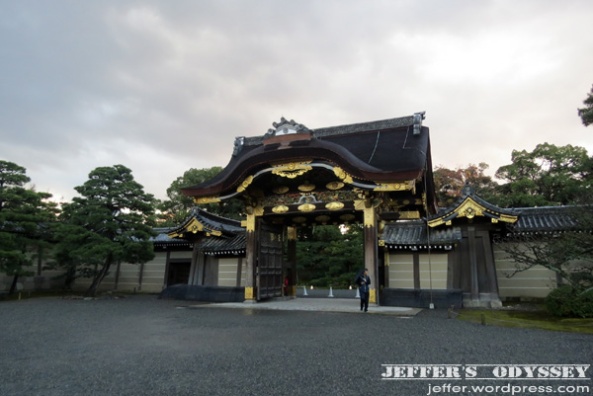 This was what we were racing to catch before they close: the Ninomaru Palace, which is treated as a National Treasure. It’s also the main attraction of the Castle. We got there just as they were letting the last guests in!
This was what we were racing to catch before they close: the Ninomaru Palace, which is treated as a National Treasure. It’s also the main attraction of the Castle. We got there just as they were letting the last guests in!
This was one of the places where I sooooo wished they allowed photography. Unfortunately, photography is strictly prohibited, mainly because the paintings, wall arts and relics are going to be damaged when exposed to flash photography.
This Palace boasts the shoin-zukuri style of architecture, something that warriors favor at the time. This is where the Shogun lived and also held office when in Kyoto.
When you go in, you will be asked to take off your footwear and leave them in the open shelves by the wide doors. You will then be directed to a wide reception area, where you will have to leave all your belongings (so no way to sneak in a camera) in secure lockers. From there, you will then be allowed to go take a walk inside the Palace.
 The structure consists of many linked sections (6 buildings in total), so it’s just like a maze when you walk inside. You’ll mainly be walking through the corridors, looking inside rooms that are fenced in (you can’t step inside). There are labels on what the rooms are for, and from what I can remember, there are waiting rooms, reception rooms, the Kuro-shoin (inner audience chamber), the Shiro-shoin (the living quarters of the Shogun), the ministers’ offices, and even an Imperial Messenger’s Room.
The structure consists of many linked sections (6 buildings in total), so it’s just like a maze when you walk inside. You’ll mainly be walking through the corridors, looking inside rooms that are fenced in (you can’t step inside). There are labels on what the rooms are for, and from what I can remember, there are waiting rooms, reception rooms, the Kuro-shoin (inner audience chamber), the Shiro-shoin (the living quarters of the Shogun), the ministers’ offices, and even an Imperial Messenger’s Room.
The Palace has a total area of 3,300 square meters and a total of 33 rooms. The wall art were fascinating, and the place was practically covered with tatami mats, or straw mats. It has more than 800 well-maintained tatami mats. There are 954 paintings inside the Palace, and they are all considered as important cultural properties of Japan.
What fascinated me most, however, is the Nightingale Floor.
Basically, it’s a huge stretch of corridor, the first one you’ll step onto upon entering the Palace. When you walk on it, no matter how lightly you try to tread, there will be a squeaking sound coming from the floor and it sounds a lot like chirping (hence the name “nightingale floor”). According to an explanation on the wall, the squeaking sound of the Nightingale Floor was to give warning when somebody sneaks in.
This was one of the inner gardens within the many linked portions of the Palace.
The place did not have any lighting, utilizing only the natural daylight streaming through slats in the windows. This partly explains why they close the place early, since visibility will be poor inside anyway if you go in at around 5pm already.
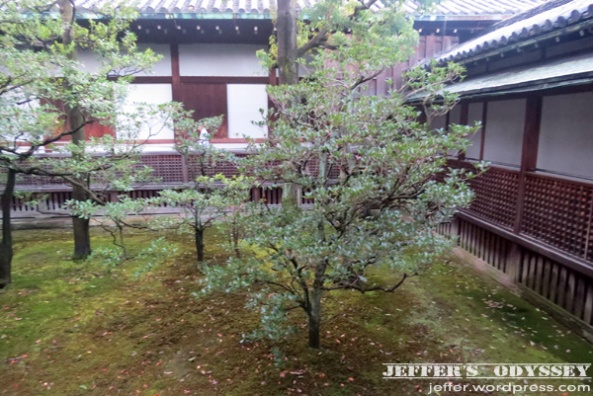
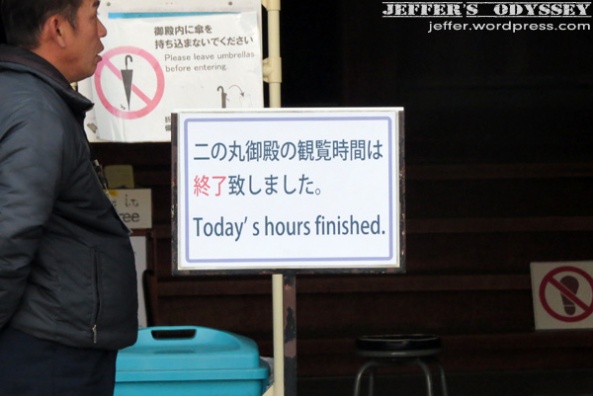 We left Ninomaru Palace to proceed to the Ninomaru Garden, which is said to have been originally designed by master garden designer Kobori Enshu.
We left Ninomaru Palace to proceed to the Ninomaru Garden, which is said to have been originally designed by master garden designer Kobori Enshu.
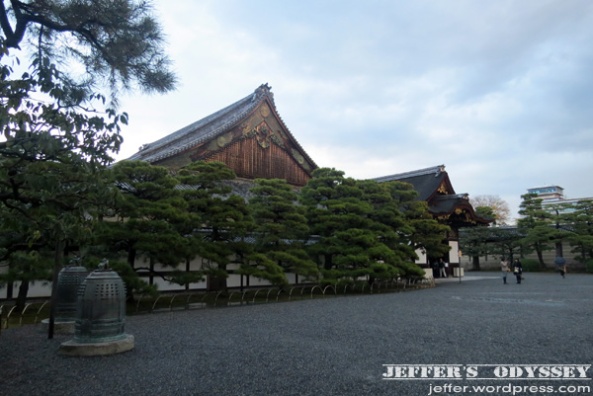

 It was sooooooo wide. There were parts that were closed off, since foot traffic may cause damage to some areas. It also has various structures and buildings that also boast shoin-zukuri style.
It was sooooooo wide. There were parts that were closed off, since foot traffic may cause damage to some areas. It also has various structures and buildings that also boast shoin-zukuri style.

 There is a large pond in the middle of the Garden, and in the center is a large island, which is said to represent Horai-jima, also known as The Island of Eternal Happiness.
There is a large pond in the middle of the Garden, and in the center is a large island, which is said to represent Horai-jima, also known as The Island of Eternal Happiness.


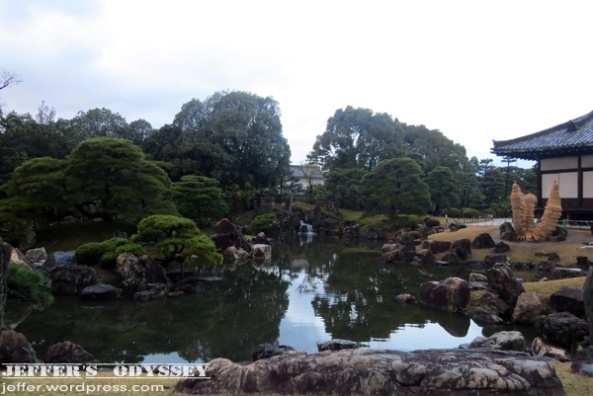
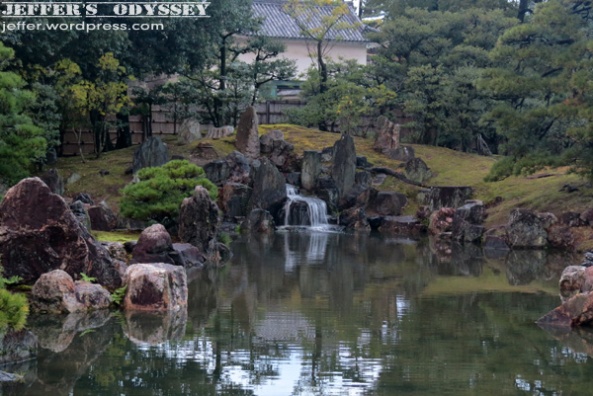 You can’t see them clearly in these pictures, but the center island is flanked by two islands – one on each side – and they are Tsuru-jima (Crane Island) and Kame-jima (Turtle Island).
You can’t see them clearly in these pictures, but the center island is flanked by two islands – one on each side – and they are Tsuru-jima (Crane Island) and Kame-jima (Turtle Island).

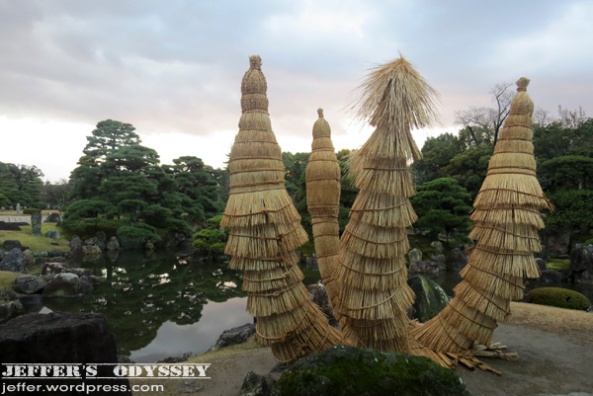 We followed a path to get to Honmaru Palace, the main circle of defense of Nijo Castle.
We followed a path to get to Honmaru Palace, the main circle of defense of Nijo Castle.
Unfortunately, it is closed to the public, so we’re allowed to just walk around the outer grounds. To get to the Honmaru Palace, you’d have to cross a bridge located over a moat.
Honmaru Palace’s highlight is the five-story castle keep. It was quite a climb to get there, and when you do, you’d get a view of the surrounding gardens and structures. It was already close to dusk when we were there so lighting was poor. And we couldn’t stay long because we can now hear notices to guests that the gates will close in a few minutes.

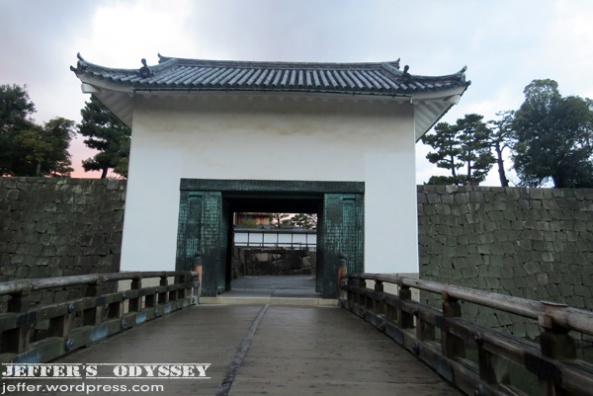
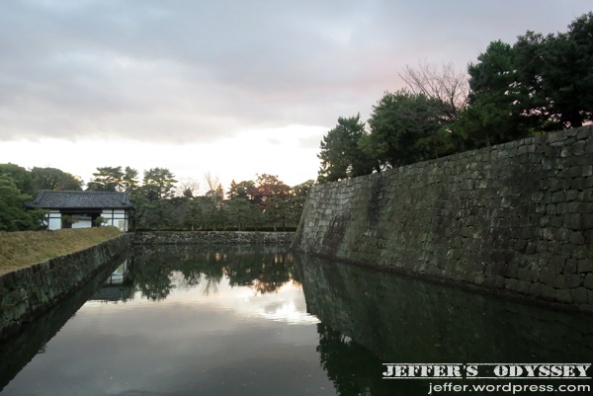

 Just like the Ninomaru Garden, the Honmaru also has gardens.
Just like the Ninomaru Garden, the Honmaru also has gardens.

 View from the top of the Castle Keep. We left the place and went round to the entrance of the Honmaru Palace. To take pictures, haha!
View from the top of the Castle Keep. We left the place and went round to the entrance of the Honmaru Palace. To take pictures, haha!
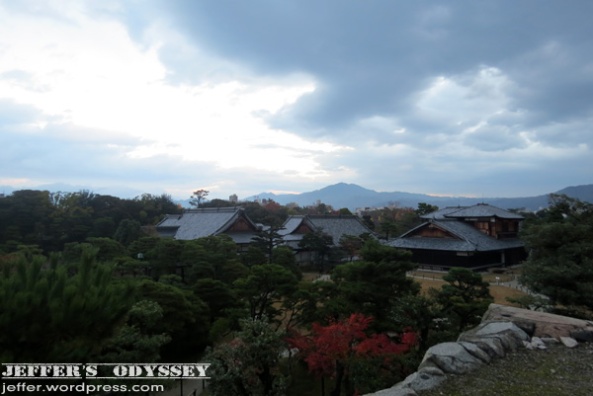
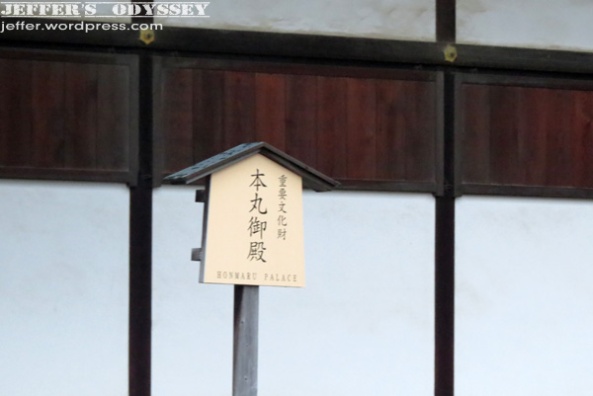
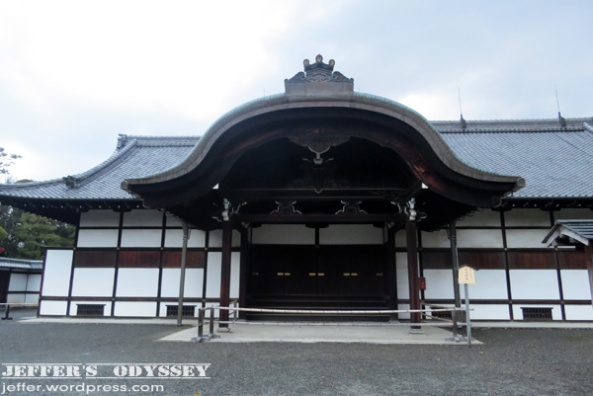 You gotta love autumn. They had this place that was packed with families taking photos. We couldn’t catch our own moments to take photos, so we just made do with what we could ‘steal’.
You gotta love autumn. They had this place that was packed with families taking photos. We couldn’t catch our own moments to take photos, so we just made do with what we could ‘steal’.

 These were verrrry interesting….. Phoenix Trees that have been exposed to the atomic bomb in Hiroshima back in 1945. There was one pathway lined with these trees.
These were verrrry interesting….. Phoenix Trees that have been exposed to the atomic bomb in Hiroshima back in 1945. There was one pathway lined with these trees.



 We finally stepped out of the Gate to formally bid Nijo Castle farewell. I want to go back here during spring, because I hear the Ninomaru and Honmaru Gardens are gorgeous with cherry blossoms in full bloom.
We finally stepped out of the Gate to formally bid Nijo Castle farewell. I want to go back here during spring, because I hear the Ninomaru and Honmaru Gardens are gorgeous with cherry blossoms in full bloom.
From Kyoto Imperial Palace, we took the subway, and rode on the Tozai Line, then stopped at Nijo-jo-mae Station. From there, the Nijo Castle is just across the street.

